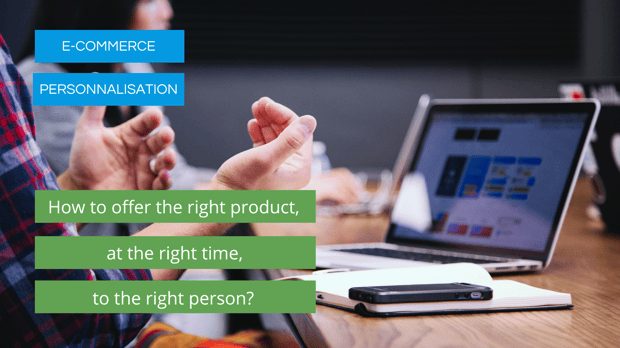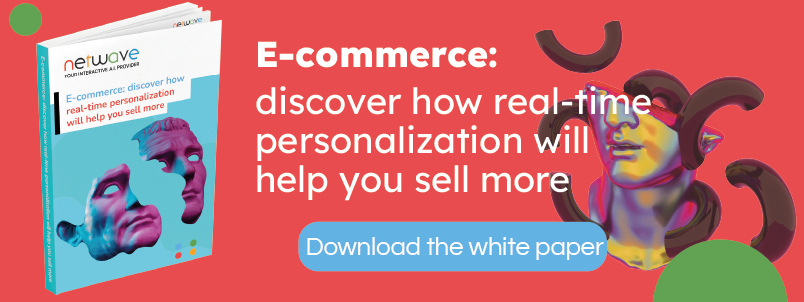
Do you want to personalise your interactions with your e-commerce site visitors? This is an excellent idea! But for effective results, you need to be able to offer the right product, at the right time, to the right person. How can you do this? Here are the answers.
Personalisation: a vital service in e-commerce
According to Movable Ink's Audience of One 2022 report, 61% of consumers say they are more likely to purchase from brands that personalise their interactions. The study also reveals a strong correlation between personalisation and long-term loyalty. 68% of consumers say they will likely remain loyal to a brand if it builds a personal relationship with them. And by "personal relationship", they mean "unique and individual": 73% of consumers expect companies to understand their unique needs and expectations.
Also, the marketers interviewed for the State of Marketing 2022 study believe that personalisation is not just about targeted messages; it is, first and foremost, about the hyper-personal understanding of consumers.
Because it influences conversion and loyalty and is now a fundamental requirement for consumers, personalisation has become essential in e-commerce. Beyond this, one question remains: how to personalise to offer the right product, at the right time, to the right person?
Offering the right product, at the right time, to the right person: 5 good practices
1. Individualising interactions
The first good practice is to individualise your approach, to meet the expectations of e-consumers on the one hand and to gain relevance on the other. Indeed, if you are content to suggest the same products or content to large segments of your visitors, there is a good chance that most of them will not be interested in these suggestions. You will then offer the right product to some of the right people, but certainly not to THE right person. The challenge is to design interactions tailored to each visitor of your e-commerce site. You should no longer think in terms of average marketing segments but in terms of individuals. And that means using data...
2. Data exploitation: the heart of personalisation
To offer the right product, at the right time, to the right person, it is essential to collect and analyse browsing data in real-time. Only in this way can you capture the individuality of your visitor for a tailor-made personalisation. But for this to work, you need to be able to collect data... At a time when third-party data is disappearing, first and zero-party data is more critical than ever. It is, therefore, essential to encourage customers to feel comfortable proactively sharing their preferences. As such, Movable Ink's Audience of One 2022 report found that customers who feel loyal to a brand are more likely to share their data with the brand. 60% of customers surveyed said they would share more information about themselves with brands they feel loyal to. Therefore, brands must prove their value to encourage a mutually beneficial 'data exchange'.
3. Weak signal analysis for a hyper-personal approach
To offer the right product, at the right time, to the right person, you must be able to capture the strong and weak signals of each Internet user to understand their real needs and accompany them throughout their journey.
Is the visitor hesitant or not? Are they sensitive to the opinions of others? What device do they use for browsing? What time of day do they visit? Are they interested in innovative products? Rare? Are they sensitive to promotions? Etc.
These weak signals constitute a significant situation that makes it possible to grasp the individuality of the visit in that it is different from other visits. Thus, it becomes possible to provide a relevant and personalised response to each person to offer them the right product.
Let's take stock of the situation at the halfway point. For relevant e-commerce personalisation, it is necessary :
- To consider each visitor in their individuality to move away from irrelevant average recommendations.
- Build trust and transparency to encourage the exchange of information that makes data mining possible.
- To consider the weak signals left by each visitor to understand their real needs and respond to them as best as possible.
These three elements will enable you to offer the right product to the right person. That’s good, but not enough. For a practical approach, you need to be able to do it at the right time! What better way to do this than to generate real-time interactions?
4. Real-time: a must for offering the right product to the right person at the right time
To offer the right product, at the right time, to the right person, you must be able to refine your recommendations at each stage of the buying process and thus analyse the slightest change in the visitor's expectations and needs in real-time. Observing the changes in Internet users' behaviour is essential because exposure to your offer can impact their purchasing path. For example, a visitor is looking for wireless headphones but notices that the e-commerce site offers headphones which, in the end, would better meet his needs. The sale may not go through if the e-commerce site does not consider this and continues to suggest headphones instead of earphones.
You also need to be able to adapt to consumer trends. Let's say a well-known influencer discredits a brand. This bad publicity will affect the buying behaviour of some consumers. They will then turn more to another brand's products. Your personalised suggestions should immediately consider this change in consumption and stop offering the products to the influencer's followers.
To match the state of mind of the Internet user and consumer trends at a given moment, automated suggestions cannot be based on fixed statistical models, trying to force the customer into a predefined segment and relying on outdated sales histories as soon as they are formulated.
Only inductive artificial intelligence is capable of implementing these personalised recommendations in real-time:
- it defines the visitor's situation in real-time during his navigation and updates it with each data received,
- it recommends what was most recently purchased in the same situation, favouring trend over statistical history.
5. Artificial intelligence for customisation
The State of Marketing 2022 study reveals that 68% of marketers say they have a fully defined AI strategy, compared to 60% in 2021 and 57% in 2020. Therefore, companies are well aware of AI's benefits and no longer hesitate to invest in intelligent personalisation solutions.
Thus, adopting the right technology to facilitate a personalised user experience can be a brand's best ally. Personalisation can make consumers' lives easier and increase satisfaction by showing them only what is most relevant. But great power can only be correlated with great responsibility. One in four consumers say that receiving irrelevant information would cause them to unsubscribe, which makes it essential for companies to deploy effective marketing personalisation. The challenge, then, is to turn to the right artificial intelligence solution...
The Netwave platform offers truly individualised personalisation in real-time. The animation of e-commerce sites (offer/content/advertising) is delegated to an inductive AI that adapts, in real-time, to the visitor's needs at each click without using a predefined model. Netwave AI reproduces the decision-making mechanisms of the human brain. Each visitor's strong and weak signals are analysed in real-time to offer genuinely individualised advice to each visitor to your site and tailor-made, in short.
With Netwave, you can be sure to offer the right product, at the right time, to the right person! Curious to see the results of Netwave with your own eyes? Request a demo!


